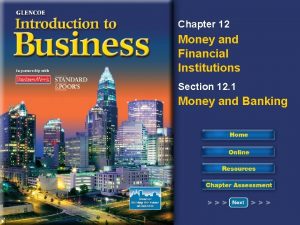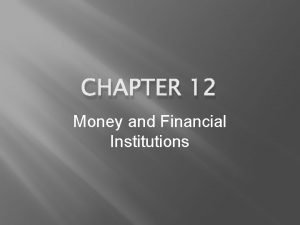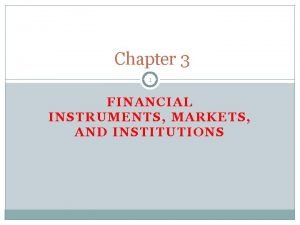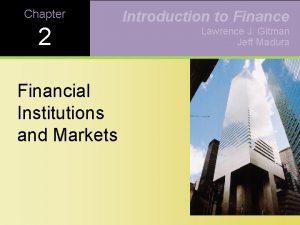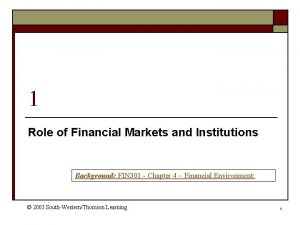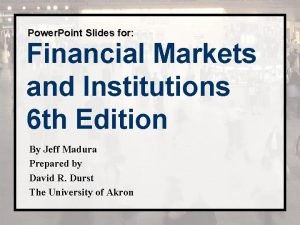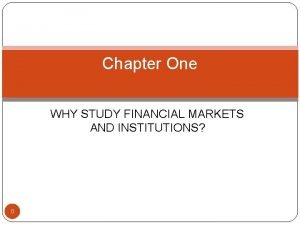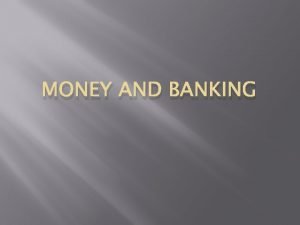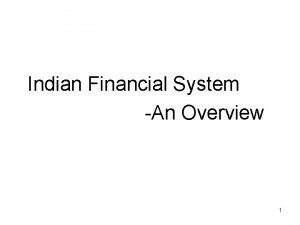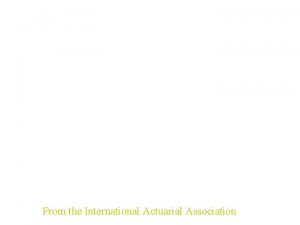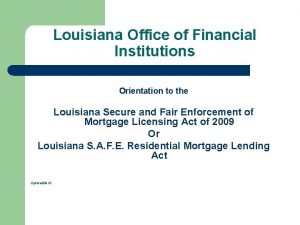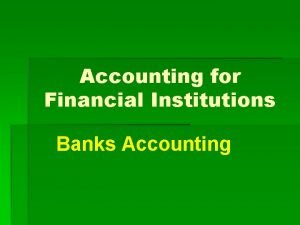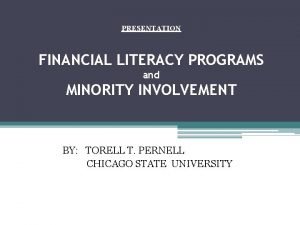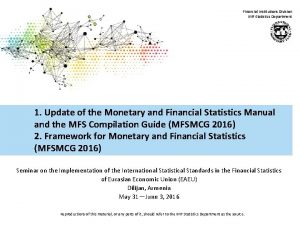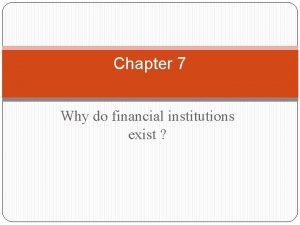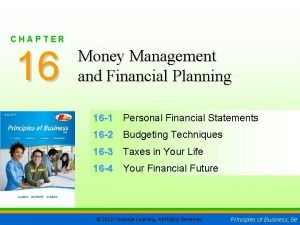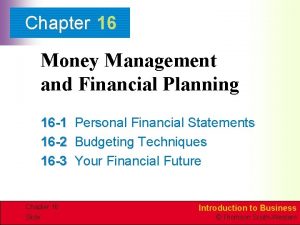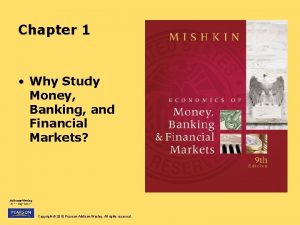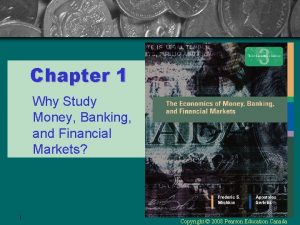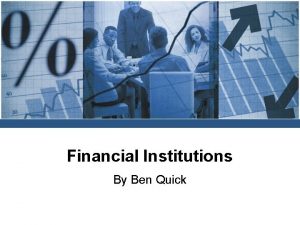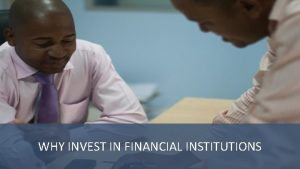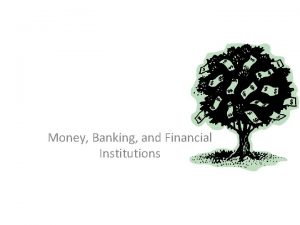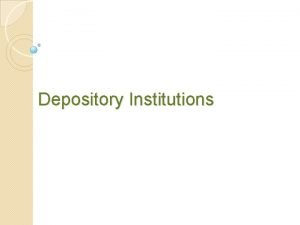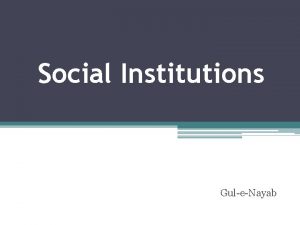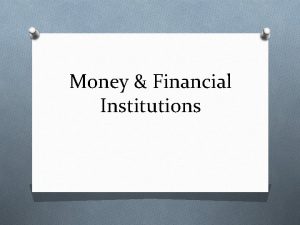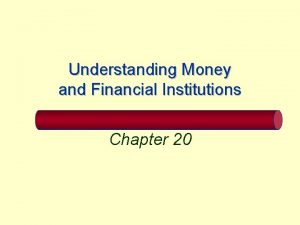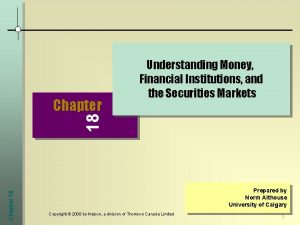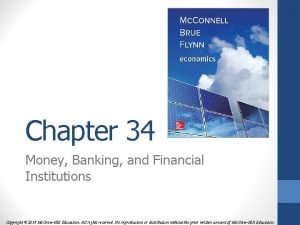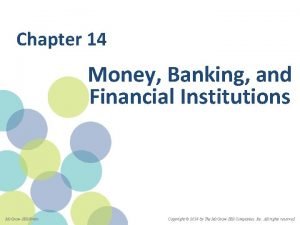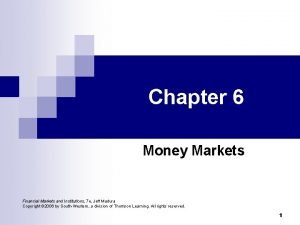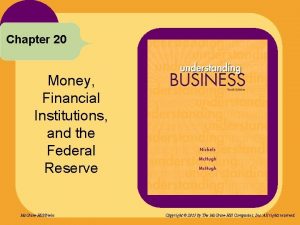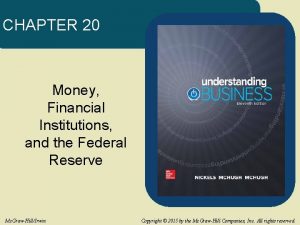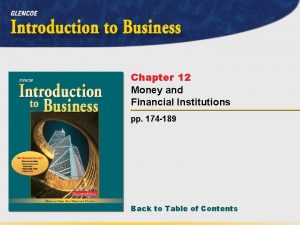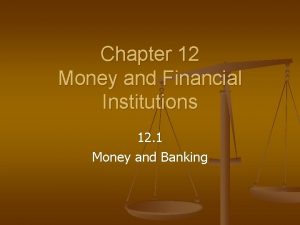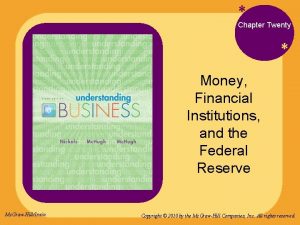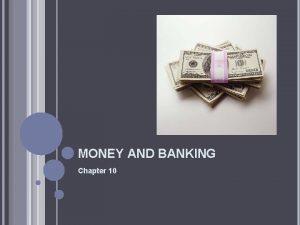MONEY AND FINANCIAL INSTITUTIONS Chapter 12 MONEY If































- Slides: 31

MONEY AND FINANCIAL INSTITUTIONS Chapter 12

MONEY • If you didn’t have money, you would have to trade. This is called? – Barter – trade goods and services for other goods and services • Monetary System – goods and services are indirectly exchanged for money

MONEY • Money – anything that people accept as a standard of payment • Must have three functions – Medium of exchange – Standard of value – Store of value

FUNCTIONS • Medium of Exchange – money is a medium to trade for goods and services – Prevents bartering • Sell tomatoes to get CDs – example • Money is NOT a good or a service – It is a means of exchanging goods and services

FUNCTIONS • Standard of Value – a fixed measure of something – How many tomatoes makes up one CD? – How many gallons of milk for a Big Mac ® – With money, these are not issues – Money has same value to everyone – Can have set values (prices) for goods and services

FUNCTIONS • Store of value – holds value over time and can be saved – Can increase money to make you wealthier – Stores very well, does not mold or fall apart

CHARACTERISTICS • In most of the world, money is paper and coins. • All money has to have the same characteristics • Characteristics: – – – Scarce Accepted Divisible Portable Durable

STOP SLIDE

BANKING • Financial Institution – organization for managing money in our economy • Banks offer several services – Storing Money – Transferring Money – Lending Money – Other

STORING MONEY • Bank Account – record of how much money a customer has deposited or withdrawn • Deposit – money put into the bank • Withdrawal – money taken out of the bank • Keeping money in bank makes it safer and harder for you to spend.

ACCOUNTS • Checking Account – Demand Deposit because you can demand that money is paid – Store money in short term – Some banks charge fees for checking accts. • Savings Account – Store money for long term – Earn interest

INTEREST • Interest is money you earn on your savings – Rate bank pays you for keeping your money –I=P*R*T • Interest = Principal * Rate * Time – Principal is your money – Rate is the % the bank pays (as a decimal) – Time is given in terms of years

INTEREST EXAMPLE • You have $1, 000, and the bank pays 3% interest, compounded yearly. How much money would you have after two years? • I=P*R*T I = 1, 000 *. 03 * 2 I = $60 Your money is P + I or 1, 000 + 60 = $1, 060

TRANSFERRING MONEY • Every business transaction involves transfer of money • Almost all transfers occur electronically • Electronic Funds Transfer – money is transferred through a network of computers – Used to give you money – Used to pay bills

LENDING MONEY • Banks lend out the money you deposit. Give this money to other people to buy things. • Bank pays you interest on the money you have in bank • Bank charges interest on the money it loans out to people • Difference in interest rates is profit for bank

TYPES OF LOANS • Mortgage Loan – loan used to buy real estate – the real estate is the collateral • Commercial Loan – loan to businesses • Individual Loan – made to people based on other collateral to allow for payment. • Line of Credit – Set aside money for use later (sometimes called a home equity loan)

Business Building Blocks How to Compute Interest Step 2. Use this formula: interest = principal x interest rate x time continued

Business Building Blocks How to Compute Interest Decimal Principal x Interest x Time Rate $1, 000 x . 10 x 3 = Interest = $300 continued

Business Building Blocks How to Compute Interest At the end of 3 years, the cost of the loan would be $300. Since you also must pay back the principal, you owe the lender $1, 300.

Figure 12. 2 HOW BANKS DO BUSINESS Banks are businesses that provide financial services to make a profit. What would happen to a bank’s profits if deposits suddenly decreased?

MORE BANK SERVICES • Safe-Deposit boxes – put valuables in and you have only access • Credit cards – Mastercard, Discover and Visa issued by banks. • Trust and estate – planning for your will • Retirement services – helping you invest for your future

TYPES OF BANKS • Banks are state, national or international • Three main types of banks: – Commercial – Savings and Loans – Credit Unions

COMMERCIAL BANKS • Sometimes called full service banks • Largest type of bank in US • Earn profit by charging higher interest on loans than they pay on savings accounts

SAVINGS AND LOANS • Charged lower interest and paid higher interest to encourage savings and help people be able to afford houses • In 1980’s about 20% of these failed • Government allowed them to charge higher interest rates • Now similar to commercial banks

CREDIT UNIONS • Non-Profit banks set up for members of an organization to use. • Lower risks, so can offer higher interest rates on savings, and lower rates on lending • Offer almost all services a bank does

OTHER FINANCIALS • Mortgage Companies – loans just for houses • Finance Companies – Short term loans with higher interest rates • Insurance Companies – Provide insurance AND loan money • Brokerage Firms – Sell stocks and bonds

THE FED • The Federal Reserve System (FED) is the central banking organization in the US. • Consists of 12 Federal Reserve Banks • 25 Branch Banks • 5, 000 member banks • Run by the Chairman of the Fed – Used to be Alan Greenspan – Now is Ben Bernanke

FED FUNCTIONS • Clearing Checks - Transferring funds from one account to another • Acting as the Federal Government’s Bank – Spends and distributes federal money on behalf of the US Treasury • Supervising Member Banks – regulates banks in the FED – necessary due to bank failures in the early 1900’s.

FUNCTIONS OF FED • Regulating the Money Supply – Determine the amount of money in circulation (Scarcity) • Setting Reserve Requirements – amount of money a bank must have on hand before it can loan money to others • Supplying Paper Currency – making the money that we use

RESERVE REQUIREMENTS • Fed determines how much money a bank must keep. • Current Reserve Requirement is about 8%. • Bank only keeps 8% of deposits, and lends out rest to others. • This lending creates money.

• Reserve Requirements and Money Creation Reserve requirements affect the potential of the banking system to create transaction deposits. If the reserve requirement is 10%, for example, a bank that receives a $100 deposit may lend out $90 of that deposit. If the borrower then writes a check to someone who deposits the $90, the bank receiving that deposit can lend out $81. As the process continues, the banking system can expand the initial deposit of $100 into a maximum of $1, 000 of money ($100+$90+81+$72. 90+. . . =$1, 000). In contrast, with a 20% reserve requirement, the banking system would be able to expand the initial $100 deposit into a maximum of $500 ($100+$80+$64+$51. 20+. . . =$500). Thus, higher reserve requirements should result in reduced money creation and, in turn, in reduced economic activity.
 Chapter 12 money and financial institutions
Chapter 12 money and financial institutions Chapter 12 money and financial institutions
Chapter 12 money and financial institutions Why study financial markets and institutions?
Why study financial markets and institutions? Dana damian
Dana damian Financial intermediaries ppt
Financial intermediaries ppt Financial markets and institutions - ppt
Financial markets and institutions - ppt Financial markets instruments and institutions
Financial markets instruments and institutions Madura j. financial markets and institutions
Madura j. financial markets and institutions Primary vs secondary financial markets
Primary vs secondary financial markets Madura j financial markets and institutions
Madura j financial markets and institutions Why study financial markets and institutions
Why study financial markets and institutions Functions of financial institutions
Functions of financial institutions Daibb management accounting question solution
Daibb management accounting question solution Regulatory institutions in indian financial system
Regulatory institutions in indian financial system Types of non banking financial institutions
Types of non banking financial institutions Enterprise risk management for financial institutions
Enterprise risk management for financial institutions Louisiana office of financial institutions
Louisiana office of financial institutions Accounting for financial institutions
Accounting for financial institutions Financial literacy at minority serving institutions
Financial literacy at minority serving institutions What is financial institutions
What is financial institutions Financial institutions division
Financial institutions division Solve the analogy
Solve the analogy Chapter 16 money management and financial planning
Chapter 16 money management and financial planning Chapter 16 money management and financial planning
Chapter 16 money management and financial planning Why study money banking and financial markets
Why study money banking and financial markets Why study money banking and financial markets
Why study money banking and financial markets Non financial method of motivation
Non financial method of motivation Great gatsby meaning
Great gatsby meaning Money smart money match
Money smart money match Money on money multiple
Money on money multiple Great gatsby historical context
Great gatsby historical context Context of the great gatsby
Context of the great gatsby
